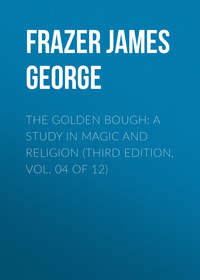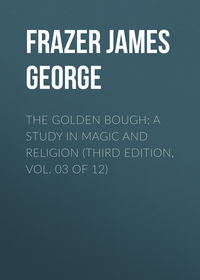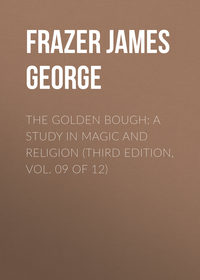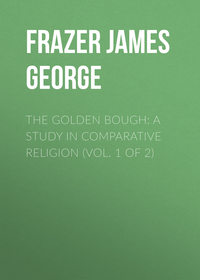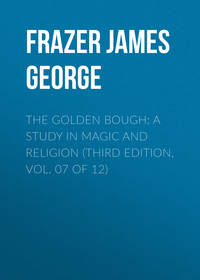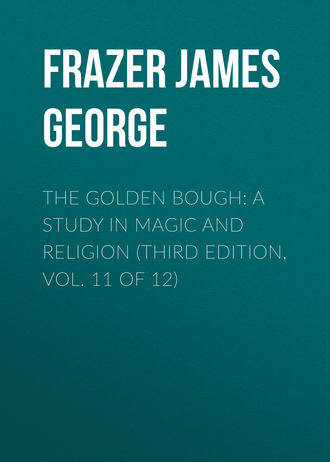 полная версия
полная версияThe Golden Bough: A Study in Magic and Religion (Third Edition, Vol. 11 of 12)
666
Fr. Boas, in Tenth Report on the North-Western Tribes of Canada, pp. 49 sq., 58 sq. (separate reprint from the Report of the British Association, Ipswich meeting, 1895). It is remarkable, however, that in this tribe persons who are being initiated into the secret societies, of which there are six, are not always or even generally brought back by an artificial animal which represents their own totem. Thus while men of the eagle totem are brought back by an eagle which rises from underground, men of the bear clan return on the back of an artificial killer-whale which is towed across the river by ropes. Again, members of the wolf clan are brought back by an artificial bear, and members of the raven clan by a frog. In former times the appearance of the artificial totem animal, or of the guardian spirit, was considered a matter of great importance, and any failure which disclosed the deception to the uninitiated was deemed a grave misfortune which could only be atoned for by the death of the persons concerned in the disclosure.
667
See above, p. 213.
668
This is the opinion of Dr. F. Boas, who writes: “The close similarity between the clan legends and those of the acquisition of spirits presiding over secret societies, as well as the intimate relation between these and the social organizations of the tribes, allow us to apply the same argument to the consideration of the growth of the secret societies, and lead us to the conclusion that the same psychical factor that molded the clans into their present shape molded the secret societies” (“The Social Organization and the Secret Societies of the Kwakiutl Indians,” Report of the United States National Museum for 1895, p. 662). Dr. Boas would see in the acquisition of a manitoo or personal totem the origin both of the secret societies and of the totem clans; for according to him the totem of the clan is merely the manitoo or personal totem of the ancestor transmitted by inheritance to his descendants. As to personal totems or guardian spirits (manitoos) among the North American Indians, see Totemism and Exogamy, iii. 370 sqq.; as to their secret societies, see id., iii. 457 sqq.; as to the theory that clan totems originated in personal or individual totems, see id., iv. 48 sqq.
669
A. G. Morice, “Notes, archaeological, industrial, and sociological, on the Western Dénés,” Transactions of the Canadian Institute, iv. (1892-93) pp. 203-206. The honorific totems of the Carrier Indians may perhaps correspond in some measure to the sub-totems or multiplex totems of the Australians. As to these latter see Totemism and Exogamy, i. 78 sqq., 133 sqq.
670
See above, pp. 153 sq.
671
James Teit, The Thompson Indians of British Columbia, p. 357 (The Jesup North Pacific Expedition, Memoir of the American Museum of Natural History, April, 1900). Among the Shuswap of British Columbia, when a young man has obtained his personal totem or guardian spirit, he is supposed to become proof against bullets and arrows (Fr. Boas, in Sixth Report of the Committee on the North-Western Tribes of Canada, p. 93, separate reprint from the Report of the British Association, Leeds meeting, 1890).
672
H. R. Schoolcraft, Indian Tribes of the United States (Philadelphia, 1853-1856), v. 683. In a letter dated 16th Dec. 1887, Mr. A. S. Gatschet, formerly of the Bureau of Ethnology, Washington, wrote to me: “Among the Toukawe whom in 1884 I found at Fort Griffin [?], Texas, I noticed that they never kill the big or grey wolf, hatchukunän, which has a mythological signification, ‘holding the earth’ (hatch). He forms one of their totem clans, and they have had a dance in his honor, danced by the males only, who carried sticks.”
673
The Laws of Manu, ii. 169, translated by G. Bühler (Oxford, 1886), p. 61 (The Sacred Books of the East, vol. xxv.); J. A. Dubois, Mœurs, Institutions et Cérémonies des Peuples de l'Inde (Paris, 1825), i. 125; Monier Williams, Religious Thought and Life in India (London, 1883), pp. 360 sq., 396 sq.; H. Oldenberg, Die Religion des Veda (Berlin, 1894), pp. 466 sqq.
674
Lampridius, Commodus, 9; C. W. King, The Gnostics and their Remains, Second Edition (London, 1887), pp. 127, 129. Compare Fr. Cumont, Textes et Monuments figurés relatifs aux mystères de Mithra, i. (Brussels, 1899) pp. 69 sq., 321 sq.; E. Rohde, Psyche3 (Tübingen and Leipsic, 1903), ii. 400 n. 1; A. Dieterich, Eine Mithrasliturgie (Leipsic, 1903), pp. 91, 157 sqq.
675
Above, p. 110; compare pp. 107, 120 sq., 132, 133.
676
Above, p. 120.
677
Above, p. 106.
678
Above, p. 145. In the myth the throwing of the weapons and of the mistletoe at Balder and the blindness of Hother who slew him remind us of the custom of the Irish reapers who kill the corn-spirit in the last sheaf by throwing their sickles blindfold at it. See Spirits of the Corn and of the Wild, i. 144. In Mecklenburg a cock is sometimes buried in the ground and a man who is blindfolded strikes at it with a flail. If he misses it, another tries, and so on till the cock is killed. See K. Bartsch, Sagen, Märchen und Gebräuche aus Mecklenburg (Vienna, 1879-1880), ii. 280. In England on Shrove Tuesday a hen used to be tied upon a man's back, and other men blindfolded struck at it with branches till they killed it. See T. F. Thiselton Dyer, British Popular Customs (London, 1876), p. 68. W. Mannhardt (Die Korndämonen, Berlin, 1868, pp. 16 sq.) has made it probable that such sports are directly derived from the custom of killing a cock upon the harvest-field as a representative of the corn-spirit. See Spirits of the Corn and of the Wild, i. 277 sq. These customs, therefore, combined with the blindness of Hother in the myth, suggest that the man who killed the human representative of the oak-spirit was blindfolded, and threw his weapon or the mistletoe from a little distance. After the Lapps had killed a bear – which was the occasion of many superstitious ceremonies – the bear's skin was hung on a post, and the women, blindfolded, shot arrows at it. See J. Scheffer, Lapponia (Frankfort, 1673), p. 240.
679
Pliny, Nat. Hist. xxiv. 12; J. Grimm, Deutsche Mythologie,4 ii. 1010. Compare below, p. 282.
680
The Satapatha Brahmana, xii. 7. 3. 1-3, translated by J. Eggeling, Part v. (Oxford, 1900) pp. 222 sq. (The Sacred Books of the East, vol. xliv.); Denham Rouse, in Folk-lore Journal, vii. (1889) p. 61, quoting Taittīrya Brāhmana, I. vii. 1.
681
Col. E. T. Dalton, “The Kols of Chota-Nagpore,” Transactions of the Ethnological Society, N.S. vi. (1868) p. 36.
682
Jens Kamp, Danske Folkeminder (Odense, 1877), pp. 172, 65 sq., referred to in Feilberg's Bidrag til en Ordbog over Jyske Almuesmål, Fjerde hefte (Copenhagen, 1888), p. 320. For a sight of Feilberg's work I am indebted to the kindness of the late Rev. Walter Gregor, M.A., of Pitsligo, who pointed out the passage to me.
683
E. T. Kristensen, Iydske Folkeminder, vi. 380, referred to by Feilberg, l. c. According to Marcellus (De Medicamentis, xxvi. 115), ivy which springs from an oak is a remedy for stone, provided it be cut with a copper instrument.
684
A. Kuhn, Die Herabkunft des Feuers und des Göttertranks2 (Gütersloh, 1886), pp. 175 sq., quoting Dybeck's Runa, 1845, pp. 62 sq.
685
A. Kuhn, op. cit. p. 176.
686
Quoted by A. Kuhn, op. cit. pp. 180 sq. In Zimbales, a province of the Philippine Islands, “a certain parasitic plant that much resembles yellow moss and grows high up on trees is regarded as a very powerful charm. It is called gay-u-ma, and a man who possesses it is called nanara gayuma. If his eyes rest on a person during the new moon he will become sick at the stomach, but he can cure the sickness by laying hands on the afflicted part.” See W. A. Reed, Negritos of Zambales (Manilla, 1904), p. 67 (Department of the Interior, Ethnological Survey Publications, vol. ii. part i.). Mr. Reed seems to mean that if a man who possesses this parasitic plant sees a person at the new moon, the person on whom his eye falls will be sick in his stomach, but that the owner of the parasite can cure the sufferer by laying his (the owner's) hands on his (the patient's) stomach. It is interesting to observe that the magical virtue of the parasitic plant appears to be especially effective at the new moon.
687
A. Wuttke, Der deutsche Volksaberglaube2 (Berlin, 1869), p. 97 § 128; L. Lloyd, Peasant Life in Sweden (London, 1870), p. 269. See above, p. 86.
688
John Hay Allan, The Bridal of Caölchairn (London, 1822), pp. 337 sq.
689
Rev. John B. Pratt, Buchan, Second Edition (Aberdeen, Edinburgh, and London, 1859), p. 342. “The corbie roup” means “the raven croak.” In former editions of this work my only source of information as to the mistletoe and oak of the Hays was an extract from a newspaper which was kindly copied and sent to me, without the name of the newspaper, by the late Rev. Walter Gregor, M.A., of Pitsligo. For my acquaintance with the works of J. H. Allan and J. B. Pratt I am indebted to the researches of my learned friend Mr. A. B. Cook, who has already quoted them in his article “The European Sky-God,” Folk-lore, xvii. (1906) pp. 318 sq.
690
M. Martin, “Description of the Western Islands of Scotland,” in J. Pinkerton's Voyages and Travels (London, 1808-1814), iii. 661.
691
See James Sowerby, English Botany, xxi. (London, 1805), p. 1470: “The Misseltoe is celebrated in story as the sacred plant of the Druids, and the Golden Bough of Virgil, which was Aeneas's passport to the infernal regions.” Again, the author of the Lexicon Mythologicum concludes, “cum Jonghio nostro,” that the Golden Bough “was nothing but the mistletoe glorified by poetical license.” See Edda Rhythmica seu Antiquior, vulgo Saemundina dicta, iii. (Copenhagen, 1828) p. 513 note. C. L. Rochholz expresses the same opinion (Deutscher Glaube und Brauch, Berlin, 1867, i. 9). The subject is discussed at length by E. Norden, P. Vergilius Maro, Aeneis Buch VI. (Leipsic, 1903) pp. 161-171, who, however, does not even mention the general or popular view (publica opinio) current in the time of Servius, that the Golden Bough was the branch which a candidate for the priesthood of Diana had to pluck in the sacred grove of Nemi. I confess I have more respect for the general opinion of antiquity than to dismiss it thus cavalierly without a hearing.
692
Virgil, Aen. vi. 203 sqq., compare 136 sqq. See Note IV. “The Mistletoe and the Golden Bough” at the end of this volume.
693
The Magic Art and the Evolution of Kings, i. 40 sqq., ii. 378 sqq. Virgil (Aen. vi. 201 sqq.) places the Golden Bough in the neighbourhood of Lake Avernus. But this was probably a poetical liberty, adopted for the convenience of Aeneas's descent to the infernal world. Italian tradition, as we learn from Servius (on Virgil, Aen. vi. 136), placed the Golden Bough in the grove at Nemi.
694
The Magic Art and the Evolution of Kings, i. 12.
695
The Magic Art and the Evolution of Kings, ii. 186, 366 note 2.
696
A custom of annually burning or otherwise sacrificing a human representative of the corn-spirit has been noted among the Egyptians, Pawnees, and Khonds. See Spirits of the Corn and of the Wild, i. 238 sq., 245 sqq., 259 sq. We have seen that in Western Asia there are strong traces of a practice of annually burning a human god. See Adonis, Attis, Osiris, Second Edition, pp. 84 sqq., 98 sq., 137 sq., 139 sqq., 155 sq. The Druids appear to have eaten portions of the human victim (Pliny, Nat. Hist. xxx. 13). Perhaps portions of the flesh of the King of the Wood were eaten by his worshippers as a sacrament. We have found traces of the use of sacramental bread at Nemi. See Spirits of the Corn and of the Wild, ii. 94 sqq.
697
It has been said that in Welsh a name for mistletoe is “the tree of pure gold” (pren puraur). See J. Grimm, Deutsche Mythologie,4 ii. 1009, referring to Davies. But my friend Sir John Rhys tells me that the statement is devoid of foundation.
698
Virgil, Aen. vi. 137 sq.: —
“Latet arbore opacaAureus et foliis et lento vimine ramus.”699
This suggestion as to the origin of the name has been made to me by two correspondents independently. Miss Florence Grove, writing to me from 10 Milton Chambers, Cheyne Walk, London, on May 13th, 1901, tells me that she regularly hangs up a bough of mistletoe every year and allows it to remain till it is replaced by the new branch next year, and from her observation “the mistletoe is actually a golden bough when kept a sufficiently long time.” She was kind enough to send me some twigs of her old bough, which fully bore out her description. Again, Mrs. A. Stuart writes to me from Crear Cottage, Morningside Drive, Edinburgh, on June 26th, 1901: “As to why the mistletoe might be called the Golden Bough, my sister Miss Haig wishes me to tell you that last June, when she was in Brittany, she saw great bunches of mistletoe hung up in front of the houses in the villages. The leaves were bright golden. You should hang up a branch next Christmas and keep it till June!” The great hollow oak of Saint-Denis-des-Puits, in the French province of Perche, is called “the gilded or golden oak” (Chêne-Doré) “in memory of the Druidical tradition of the mistletoe cut with a golden sickle.” See Felix Chapiseau, Le Folk-lore de la Beauce et du Perche (Paris, 1902), i. 97. Perhaps the name may be derived from bunches of withered mistletoe shining like gold in the sunshine among the branches.
700
H. Gaidoz, “Bulletin critique de la Mythologie Gauloise,” Revue de l'Histoire des Religions, ii. (Paris, 1880) p. 76.
701
See below, pp. 291 sq.
702
See above, pp. 65 sq.
703
J. V. Grohmann, Aberglauben und Gebräuche aus Böhmen und Mähren (Prague and Leipsic, 1864), p. 97, § 673.
704
J. V. Grohmann, op. cit. p. 97, § 676; A. Wuttke, Der deutsche Volksaberglaube2 (Berlin, 1869), p. 94, § 123; I. V. Zingerle, Sitten, Bräuche und Meinungen des Tiroler Volkes2 (Innsbruck, 1871), p. 158, § 1350.
705
C. Russwurm, “Aberglaube in Russland,” Zeitschrift für deutsche Mythologie und Sittenkunde, iv. (1859), pp. 152 sq.; Angelo de Gubernatis, Mythologie des Plantes (Paris, 1878-1882), ii. 146.
706
P. Sébillot, Traditions et Superstitions de la Haute-Bretagne (Paris, 1882), ii. 336; id., Coutumes populaires de la Haute-Bretagne (Paris, 1886), p. 217.
707
J. E. Waldfreund, “Volksgebräuche und Aberglauben in Tirol und dem Salzburger Gebirg,” Zeitschrift für deutsche Mythologie und Sittenkunde, iii. (1855), p. 339.
708
H. Runge, “Volksglaube in der Schweiz,” Zeitschrift für deutsche Mythologie und Sittenkunde, iv. (1859), p. 175.
709
O. Frh. von Reinsberg-Düringsfeld, Fest-Kalendar aus Böhmen (Prague, n. d.), pp. 311 sq. Compare Theodor Vernaleken, Mythen und Bräuche des Volkes in Oesterreich (Vienna, 1859), pp. 309 sq.; M. Töppen, Aberglauben aus Masuren2 (Danzig, 1867), pp. 72 sq. Even without the use of fern-seed treasures are sometimes said to bloom or burn in the earth, or to reveal their presence by a bluish flame, on Midsummer Eve; in Transylvania only children born on a Sunday can see them and fetch them up. See J. Haltrich, Zur Volkskunde der Siebenbürger Sachsen (Vienna, 1885), p. 287; I. V. Zingerle, Sitten, Bräuche und Meinungen des Tiroler Volkes2 (Innsbruck, 1871), p. 159, §§ 1351, 1352; K. Bartsch, Sagen, Märchen und Gebrauche aus Mecklenburg (Vienna, 1879-1880), ii. 285, § 1431; E. Monseur, Folklore Wallon (Brussels, n. d.), p. 6, § 1789; K. Haupt, Sagenbuch der Lausitz (Leipsic, 1862-1863), i. 231 sq., No. 275; A. Wuttke, Der deutsche Volksaberglaube2 (Berlin, 1869), p. 76, § 92; F. J. Wiedemann, Aus dem inneren und äusseren Leben der Ehsten (St. Petersburg, 1876), p. 363.
710
I. V. Zingerle, op. cit. p. 103, § 882; id., in Zeitschrift für deutsche Mythologie und Sittenkunde, i. (1853), p. 330; W. Müller, Beiträge zur Volkskunde der Deutschen in Mähren (Vienna and Olmütz, 1893), p. 265. At Pergine, in the Tyrol, it was thought that fern-seed gathered with the dew on St. John's night had the power of transforming metals (into gold?). See Ch. Schneller, Märchen und Sagen aus Wälschtirol (Innsbruck, 1867), p. 237, § 23.
711
I. V. Zingerle, Sitten, Bräuche und Meinungen des Tiroler Volkes,2 pp. 190 sq., § 1573.
712
A. Schlossar, “Volksmeinung und Volksaberglaube aus der deutschen Steiermark,” Germania, N.R., xxiv. (1891) p. 387.
713
Ernst Meier, Deutsche Sagen, Sitten und Gebräuche aus Schwaben (Stuttgart, 1852), pp. 242-244.
714
J. V. Grohmann, Aberglauben und Gebräuche aus Böhmen und Mähren, p. 97, § 675; W. R. S. Ralston, Songs of the Russian People, Second Edition (London, 1872), p. 98; C. Russwurm, “Aberglaube in Russland,” Zeitschrift für deutsche Mythologie und Sittenkunde, iv. (1859) p. 152.
715
L. Bechstein, Deutsches Sagenbuch (Leipsic, 1853), p. 430, No. 500; id., Thüringer Sagenbuch (Leipsic, 1885), ii. pp. 17 sq., No. 161.
716
For gathering it at midsummer, see above, pp. 86 sq. The custom of gathering it at Christmas still commonly survives in England. At York “on the eve of Christmas-day they carry mistletoe to the high altar of the cathedral, and proclaim a public and universal liberty, pardon and freedom to all sorts of inferior and even wicked people at the gates of the city, toward the four quarters of heaven.” See W. Stukeley, The Medallic History of Marcus Aurelius Valerius Carausius, Emperor in Britain (London, 1757-1759), ii. 164; J. Brand, Popular Antiquities of Great Britain (London, 1882-1883), i. 525. This last custom, which is now doubtless obsolete, may have been a relic of an annual period of license like the Saturnalia. The traditional privilege accorded to men of kissing any woman found under mistletoe is probably another relic of the same sort. See Washington Irving, Sketch-Book, “Christmas Eve,” p. 147 (Bohn's edition); Marie Trevelyan, Folk-lore and Folk-stories of Wales (London, 1909), p. 88.
717
A. A. Afzelius, Volkssagen und Volkslieder aus Schwedens älterer und neuerer Zeit (Leipsic, 1842), i. 41 sq.; J. Grimm, Deutsche Mythologie,4 iii. 289; L. Lloyd, Peasant Life in Sweden (London, 1870), pp. 266 sq. See above, p. 69. In the Tyrol they say that if mistletoe grows on a hazel-tree, there must be a treasure under the tree. See J. N. Ritter von Alpenburg, Mythen und Sagen Tirols (Zurich, 1857), p. 398. In East Prussia a similar belief is held in regard to mistletoe that grows on a thorn. See C. Lemke, Volksthümliches in Ostpreussen (Mohrungen, 1884-1887), ii. 283. We have seen that the divining-rod which reveals treasures is commonly cut from a hazel (above, pp. 67 sq.).
718
Above, pp. 90-92.
719
Fern-seed is supposed to bloom at Easter as well as at Midsummer and Christmas (W. R. S. Ralston, Songs of the Russian People, pp. 98 sq.); and Easter, as we have seen, is one of the times when fires are ceremonially kindled, perhaps to recruit the fire of the sun.
720
Miss C. S. Burne and Miss G. F. Jackson, Shropshire Folk-lore (London, 1883), p. 242.
721
Marie Trevelyan, Folk-lore and Folk-stories of Wales (London, 1909), p. 88.
722
Pliny, Nat. Hist. xvi. 251.
723
Above, pp. 82 sq.
724
Pliny, Nat. Hist. xxxiii. 94: “Calx aqua accenditur et Thracius lapis, idem oleo restinguitur, ignis autem aceto maxime et visco et ovo.”
725
See above, p. 85.
726
Virgil, Aen. vi. 179-209.
727
Virgil, Aen. vi. 384-416.
728
Above, pp. 86, 282.
729
Above, p. 85.
730
Pausanias, x. 30. 6.
731
J. Six, “Die Eriphyle des Polygnot,” Mittheilungen des kaiserlich deutschen Archaeologischen Instituts, Athenische Abtheilung, xix. (1894) pp. 338 sq. Compare my commentary on Pausanias, vol. v. p. 385.
732
The sarcophagus is in the Lateran Museum at Rome. See W. Helbig, Führer durch die öffentlichen Sammlungen Klassischer Altertümer in Rom2 (Leipsic, 1899), ii. 468.
733
See The Magic Art and the Evolution of Kings, i. 19 sqq.
734
Die Edda, übersetzt von K. Simrock8 (Stuttgart, 1882), p. 264.
735
S. Powers, Tribes of California (Washington, 1877), p. 171.
736
S. Powers, Tribes of California, p. 287.
737
Max Girschner, “Die Karolineninsel Namöluk und ihre Bewohner,” Baessler-Archiv, ii. (1912) p. 141.
738
A. A. Macdonell, Vedic Mythology (Strasburg, 1897), pp. 91 sq., referring to Rigveda, vi. 3. 3, x. 79. 7, ii. 1. 14, iii. 1. 13, x. 1. 2, viii. 43. 9, i. 70. 4, ii. 1. 1. Compare H. Oldenberg, Die Religion des Veda (Berlin, 1894), pp. 120 sq.




